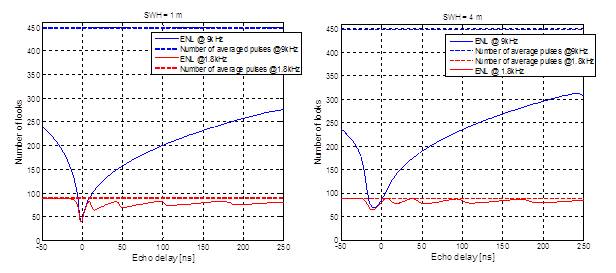Abstract's details
Pulse Limited waveforms from interleaved mode: an analysis on the achievable speckle reduction
Event: 2016 Ocean Surface Topography Science Team Meeting
Session: Instrument Processing: Measurement and retracking (SAR and LRM)
Presentation type: Oral
The main payload of Sentinel-6 is a radar altimeter named Poseidon-4 and it will be the first altimeter able to operate in interleaved mode. Poseidon-4 interleaved mode acts just like a Pulse Limited altimeter, but at a much higher rate (~9 kHz). The advantages given by the interleaved mode are twofold: firstly the number of single looks waveforms that are gathered in high-resolution mode is increased, and secondly it allows the simultaneous production of low-resolution echoes on-board as well as of high-resolution echoes on-ground.
Recalling that a PRF of about 1800 Hz (i.e. the Walsh limit) is needed to ensure that successive pulses are only partially correlated and that speckle reduction can be achieved through incoherent averaging, as discussed in [1] the received pulses from an instrument operating in interleaved mode at higher rate can go through two different processing:
- Incoherent average of all the pulses: waveforms not statistically equivalent to typical Pulse Limited instrument but higher speckle reduction expected;
- Incoherent average of one out of 5 received pulses to reduce the rate to about 1800 Hz: waveforms statistically equivalent to typical Pulse Limited instrument.
In this abstract it has been theoretically derived the expected speckle reduction that is achievable on the Low Resolution waveforms from an instrument operating in interleaved mode exploiting both approaches described above. The correlation function for the Poseidon-4 received power echoes has been computed and then it has been used to estimate the Equivalent Number of Looks (ENL) of the Pulse Limited waveform. The ENL is defined as the estimate of the effective number of statistically independent looks for the backscattered power and its upper bound is the number of single look echo waveforms that are averaged together, so that as the ENL increases the speckle reduction increases.
The attached figure shows the comparison of the achievable ENL in case of pulse limited waveforms by averaging echoes at ~9 kHz or at ~1.8 kHz (i.e. after decimation). It can be noticed that
- around the zero delay, corresponding to the leading edge, the ENL is approximately the same for both the approaches, while at higher delay the ENL for waveforms at higher rate increases;
- the ENL, and in turn the speckle reduction, increases as the SWH increases;
- averaging all the pulses at 9kHz, the ENL does not approach the number of average pulses and this can be linked to the high correlation among pulses at a high PRF.
[1] JASON‐CS SAR MODE ERROR BUDGET STUDY REVIEW OF STATE OF KNOWLEDGE FOR SAR ALTIMETRY OVER OCEAN, EUM/RSP/REP/14/749304, 21 NOVEMBER 2013, VERSION 2.2

Recalling that a PRF of about 1800 Hz (i.e. the Walsh limit) is needed to ensure that successive pulses are only partially correlated and that speckle reduction can be achieved through incoherent averaging, as discussed in [1] the received pulses from an instrument operating in interleaved mode at higher rate can go through two different processing:
- Incoherent average of all the pulses: waveforms not statistically equivalent to typical Pulse Limited instrument but higher speckle reduction expected;
- Incoherent average of one out of 5 received pulses to reduce the rate to about 1800 Hz: waveforms statistically equivalent to typical Pulse Limited instrument.
In this abstract it has been theoretically derived the expected speckle reduction that is achievable on the Low Resolution waveforms from an instrument operating in interleaved mode exploiting both approaches described above. The correlation function for the Poseidon-4 received power echoes has been computed and then it has been used to estimate the Equivalent Number of Looks (ENL) of the Pulse Limited waveform. The ENL is defined as the estimate of the effective number of statistically independent looks for the backscattered power and its upper bound is the number of single look echo waveforms that are averaged together, so that as the ENL increases the speckle reduction increases.
The attached figure shows the comparison of the achievable ENL in case of pulse limited waveforms by averaging echoes at ~9 kHz or at ~1.8 kHz (i.e. after decimation). It can be noticed that
- around the zero delay, corresponding to the leading edge, the ENL is approximately the same for both the approaches, while at higher delay the ENL for waveforms at higher rate increases;
- the ENL, and in turn the speckle reduction, increases as the SWH increases;
- averaging all the pulses at 9kHz, the ENL does not approach the number of average pulses and this can be linked to the high correlation among pulses at a high PRF.
[1] JASON‐CS SAR MODE ERROR BUDGET STUDY REVIEW OF STATE OF KNOWLEDGE FOR SAR ALTIMETRY OVER OCEAN, EUM/RSP/REP/14/749304, 21 NOVEMBER 2013, VERSION 2.2
Contribution: IPM_05_scagliola_OSTST_2016_v3_17h15.pdf (pdf, 859 ko)
Back to the list of abstract